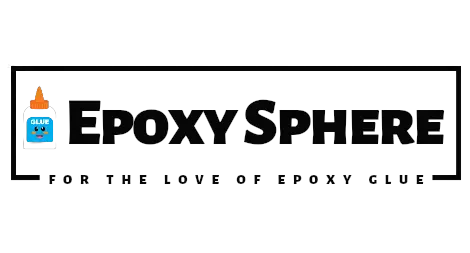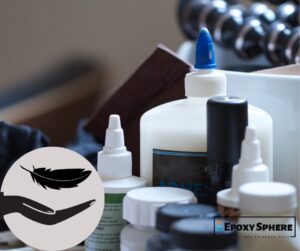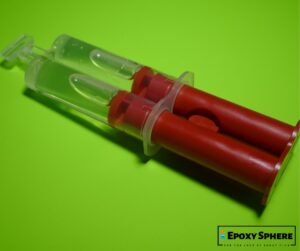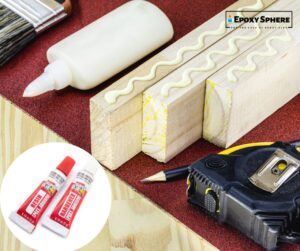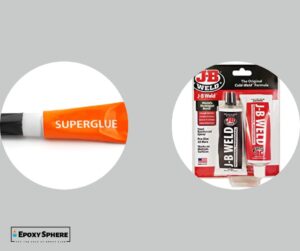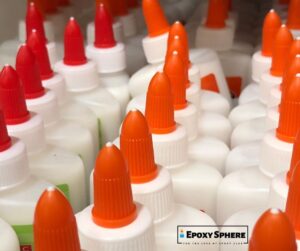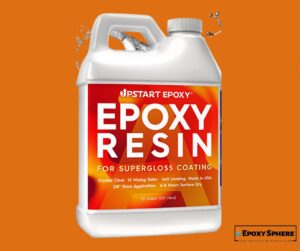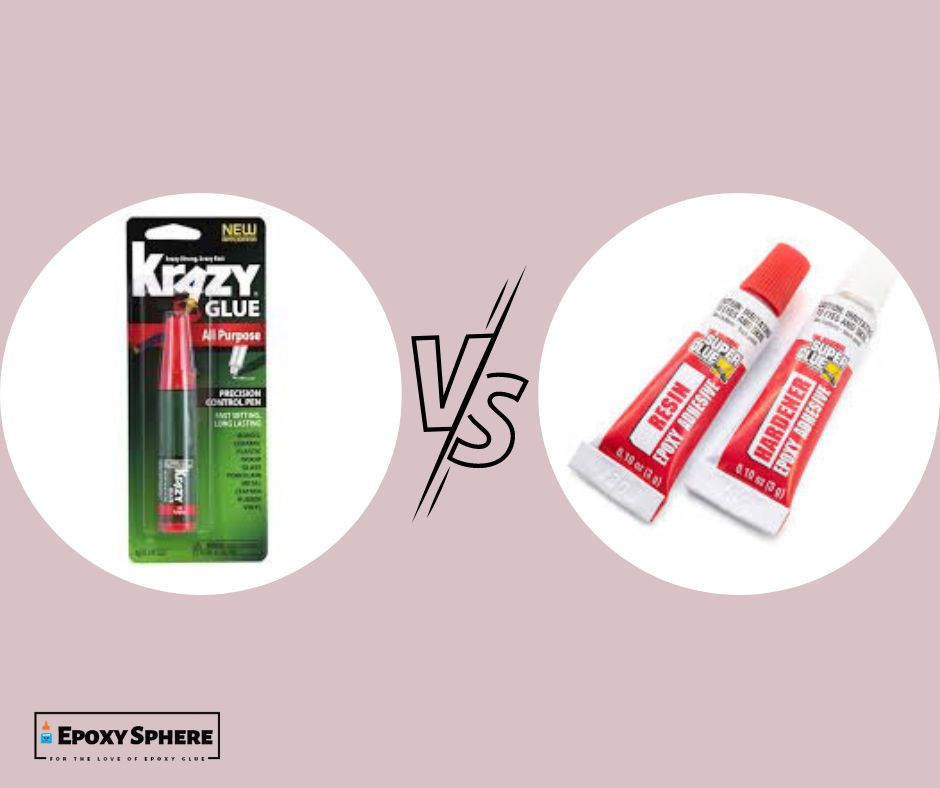
Have you ever wondered whether to use “Krazy Glue Vs Epoxy” when fixing something? I’ve used both quite a few times and it can be tricky knowing which one to use.
They both have their own set of downsides and benefits. Therefore, I wrote this post to help you decide what is best for the job. Let’s get started.
The main difference between Krazy glue and Epoxy glue is that Krazy glue dries clear while Epoxy can be colored when mixed with dye or pigment.
Krazy Glue and epoxy are two different adhesives that can glue wood or metal. Both types of glue will create a permanent bond between the materials you are trying to glue together.
Other Differences Between Krazy Glue Vs Epoxy
The following are other differences between Krazy glue and Epoxy:
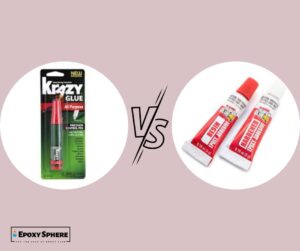
1. How they work
Krazy glue is an adhesive that is made from a chemical called cyanoacrylate. It is a strong and fast-drying adhesive that works well on many surfaces. It’s an ideal choice for gluing wood, metal, glass, and plastic.
Krazy glue (sometimes called crazy glue) is an acrylic rubber resin glue that dries fast after being exposed to air. Its strong bond causes it to be great for repairing broken objects.
Epoxy is a two-part adhesive that cures at room temperature. It comes in two components: a resin and a hardener. The resin contains epoxy groups, which are reactive molecules that link to each other when combined with the hardener.
The resulting chemical reaction causes the two parts to bond together, creating a solid adhesive.
2. Strength of Adhesion
Krazy Glue and epoxy are both strong adhesives that can hold items together even under high pressure.
However, epoxy glue has a higher strength rating than Krazy Glue because it contains two parts: an adhesive resin and a hardener that activates once combined with water.
Epoxy’s high strength rating makes it ideal for projects such as making furniture or gluing large objects together.
3. Speed of cure time
The speed of cure time is one of the biggest differences between Krazy glue and Epoxy. Krazy glue dries within seconds, while epoxy can take up to 24 hours or more to dry completely. If you need something to bond with right away, Krazy glue is your best option.
Also, the speed of cure time depends on how thickly you apply your layer of glue. Thicker layers take longer to cure while thinner layers set faster. It’s also important to note that epoxies don’t always have great gap-fill properties, so if there are gaps in your joint, they may not fill them.
4. Shelf life
The shelf life between Krazy glue and Epoxy is different as well. Krazy glue can be kept on the shelf for up to one year after opening, but epoxy should be used within two years of purchase. But above all, it depends on the product and the durability of its ingredients.
5. Application
Krazy glue can repair most household items, such as broken glasses, ceramics, or even a cracked tooth! It is also useful for making temporary repairs on furniture and other items.
You can use this to make repairs on your car as well by using it to fix broken windscreens or windows.
On the other hand, epoxy is used mostly in industrial applications where there are high demands for strength and durability. It can repair cracks in concrete structures like bridges or dams, too.
What Does Krazy Glue Not Stick To?
The following materials may not hold strong with Krazy glue:
1. Ceramic Tiles
This one isn’t surprising, but ceramic tiles will not work well with Krazy Glue. The surface is too smooth and slippery for the glue to get a grip on it.
2. Nontoxic Wood
Non-toxic wood is just as slippery as ceramic tiles, so they won’t work either.
3. Metals
Metals are very smooth and hard, so they don’t work well with any type of glue. Unless you’re using epoxy or some other specialized glue, stay away from metals when applying Krazy Glue.
4. Treated wood
Wood that has been treated with wax or oil will not work well with Krazy Glue either. Apply your wood sealant before using this adhesive.
What Does Epoxy Not Stick To?
Epoxy does not stick to plastic. Epoxy is an adhesive, so it attaches to materials that can bond with an epoxy resin.
Plastic is a thermoplastic, which means it softens when heat is applied and hardens when cooled. This property makes it resistant to sticking or bonding with other materials.
Plastic tends to be made up of polythene, which is a polymer that has a very high molecular weight. Epoxy adhesives are made up of two smaller molecules that bond together and cure when the two parts mix in specific ratios.
This means that the two parts do not have enough surface area to connect and create an effective bond between them.
Can You Use Krazy Glue In Place Of Epoxy?
It depends on what type of project you’re working on. Krazy Glue offers excellent adhesion for porous materials like wood, but it isn’t as strong as epoxy at all.
This makes it a poor choice for larger projects that require a lot of strength, especially if they’re exposed to moisture or wear and tear.
But there are some situations where use Krazy Glue in place of epoxy. For example, if you need a quick fix to fix a broken piece of glass or plastic, then Krazy Glue will work just fine.
Benefits Of Krazy Glue
The Krazy Glue brand is one of the most popular, and it’s easy to see why. The convenient glue stick allows you to fix anything in seconds. Here are some benefits of Krazy Glue:
1. Sticks to Almost Anything
The main reason people love Krazy Glue is that it sticks to almost any surface. Whether it’s metal, plastic, glass, or wood, this adhesive can hold on tight and keep your objects together for a while.
2. It is Easy To Use
Most glues require you to apply them with a brush or a syringe, which makes them difficult to use when you’re in a hurry. With Krazy Glue, however, all you need is a small amount of pressure from your thumb and an object will be secured in no time at all.
3. Strong Bonding Power
You can use this adhesive on almost any material, whether it’s plastic or metal, and still, get an extremely strong bond that will last for years without breaking apart. This means that you’ll never have to worry about accidentally snapping off pieces again.
Benefits Of Epoxy Glue
Here are some benefits of using epoxy glue on your projects:
1. It’s Waterproof
One great thing about epoxy glue is that it’s waterproof, which means you can use it outdoors or indoors. This makes it ideal for all sorts of projects where water may be involved, such as filling cracks or repairing leaky pipes, and so forth
2. Strong Hold
Epoxy adhesives form a strong bond between two surfaces and will not come apart easily after being applied correctly. The strength of an epoxy bond depends on the kind of epoxy you are using, but most forms will provide a very strong hold when used correctly.
3. Can Bond Many Materials Together
Epoxy adhesives can bond many types of materials together, including metal, as well as wood, and glass. While not all epoxies will work with all materials, most will bond with at least one material other than itself, requiring no special preparation beforehand.
4. High Shear Strength
One of the main benefits of epoxy glue is that it has high shear strength and great gap-filling properties.
This means that it provides a strong bond between two or more surfaces, even if they aren’t perfectly flush with each other when the adhesive comes into contact with both sides at once.
The high shear strength also means that epoxy glues are less likely to fall apart after being exposed to high amounts of force during use (such as when drilling holes).
In Conclusion
By now, it should be quite clear which adhesive you should reach for in any situation. Both epoxy and Krazy glue have their positives and negatives and, depending on the situation, one might be more applicable than the other. (01)

Hi, This is John Davis. After years of working in the construction industry, I decided to create a website that would provide people with information about glue and its exceptional uses. I hope You find it useful
